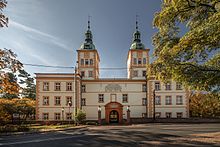| Prószków Proskau | |
|---|---|
 Historic townhouses at the Market Square Historic townhouses at the Market Square | |
 Coat of arms Coat of arms | |
 | |
| Coordinates: 50°34′35″N 17°52′17″E / 50.57639°N 17.87139°E / 50.57639; 17.87139 | |
| Country | |
| Voivodeship | Opole |
| County | Opole |
| Gmina | Prószków |
| Area | |
| • Total | 16.31 km (6.30 sq mi) |
| Population | |
| • Total | 2,570 |
| • Density | 160/km (410/sq mi) |
| Time zone | UTC+1 (CET) |
| • Summer (DST) | UTC+2 (CEST) |
| Postal code | 46-060 |
| Vehicle registration | PKL |
| Highways | |
| Voivodeship roads | |
| Website | http://www.proszkow.pl/ |
Prószków (, German: Proskau) is a town in Opole County, Opole Voivodeship in southern Poland. It is the administrative seat of Gmina Prószków, a Polish/German bilingual commune since 2006.
Geography
The town is located in the historic Upper Silesia region, about 10 km (6.2 mi) south of Opole. As of 2019 it has 2,570 inhabitants.
On July 29, 1921, a temperature of 40.2 °C (104 °F) was recorded in the city. Since then, it is the highest temperature ever recorded in any city located in present-day Poland (the town was then a part of Germany).
History

Prószków in the Silesian Duchy of Opole of fragmented Poland was first mentioned in a 1250 deed. From the 14th century onwards the estates were held by the Prószkowski (also known as Pruskowski, Pruskovsky, von Proskau) noble family. In fact, the noble family's surname is after the name of the town. Count George von Proskau had the parish church and a Renaissance castle built in the late 16th century, which both were set ablaze by Swedish troops during the Thirty Years' War and had to be rebuilt in their present Baroque style after the war.

After the First Silesian War the town passed from Bohemian sovereignty and became part of Prussia in 1742 under the Germanized name Proskau. From 1763 the castle housed a famous faience manufacture, founded by count Leopold Prószkowski. The faience was sold mainly throughout Prussia, Poland and Austria. After the death of Count Leopold von Proskau in 1769 his estate (including the manufacture) passed to Karl Maximilian, Prince of Dietrichstein, which moved its most valuable collections, including the library, treasury and archive, to another location in then Austria in 1782, and eventually sold the estate to the Prussian king Frederick the Great in 1783. Part of the collection was found in 2011 in Brno and Mikulov in the Czech Republic. From 1871 to 1945 the town was part of Germany. From 1847 the castle was used as an agronomic college. Many Poles attended the college, and a Polish library and the Literary and Agricultural Society of Polish Students were founded in 1856 and 1860, respectively. The college was relocated to Berlin in 1881. The succeeding institute for pomological research, founded in 1868, including an arboretum and extensive orchards, exists up to today. Polish students of both schools operated a secret resistance organization to provide Polish patriotic education to the local population and prevent its Germanization.
After World War II only parts of the German population were expelled in accordance with the Potsdam Agreement. Prószków regained a town charter in 2004, it officially adopted its German name Proskau as a second name on 30 April 2010.
The coat of arms of the town is after that of the Prószkowski family.
Transport
The Polish A4 motorway and Voivodeship roads 414 and 429 run through Prószków.
Twin towns – sister cities
See twin towns of Gmina Prószków.
References
- "Population. Size and structure and vital statistics in Poland by territorial division in 2019. As of 30th June". stat.gov.pl. Statistics Poland. 2019-10-15. Retrieved 2020-02-14.
- "Rekordy klimatyczne w Polsce". Klimat.Geo.UJ.edu.pl (in Polish). Zakład Klimatologii – Uniwersytet Jagielloński, Kraków. Archived from the original on 29 May 2010. Retrieved 20 August 2010.
- Mainuš, F. (1958). "Prószkowska manufaktura wyrobów fajansowych w latach 1769–1783". Śląski Kwartalnik Historyczny Sobótka (in Polish). XIII (2). Wrocław: Zakład Narodowy im. Ossolińskich: 224.
- Mainuš, p. 237
- ^ Mariusz Jarzombek. "Prószkowski skarb odnalazł się w czeskim Brnie". Nowa Trybuna Opolska (in Polish). Retrieved 14 March 2020.
- Chamcówna, Mirosława (1949). "Z życia studentów polskich w Prószkowie na Opolszczyźnie w drugiej połowie XIX w.". Sobótka (in Polish). IV (4). Wrocław: 124.
- Chamcówna, p. 135
- Chamcówna, pp. 126, 136–137
External links
- Official website (in Polish)
| Gmina Prószków | ||
|---|---|---|
| Town and seat |  | |
| Villages | ||